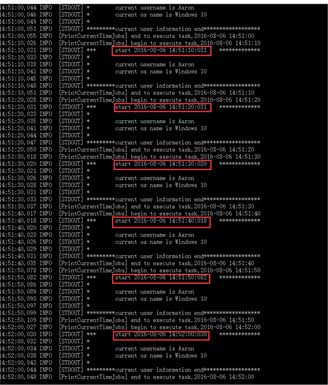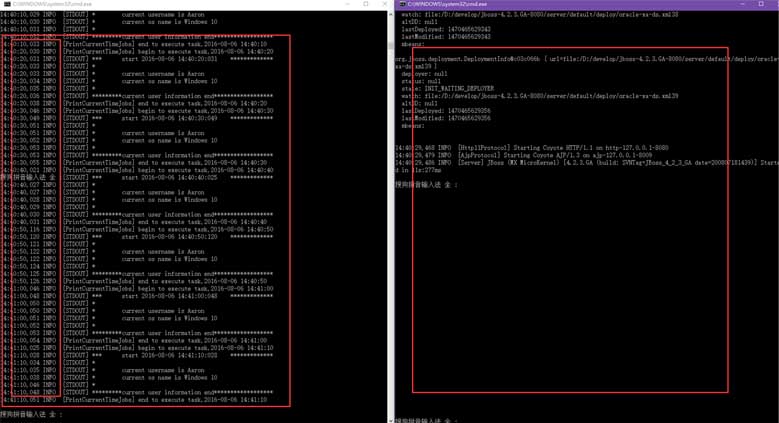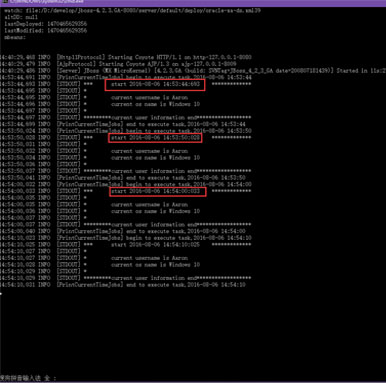
問題の背景
当社は現在 200 名の従業員を擁する急成長中のスタートアップ企業で、主なビジネスはアプリケーションの反復と更新のサイクルが比較的速いです。反復のペースが増加し、システム全体の制御ができなくなりました
クラスターが存在する前は、会社のスケジュールされたタスクが実装されていました
初期の頃、アプリケーションへのアクセス数は 1 つのサーバーではそれほど多くありませんでした。十分に使用でき、スケジュールされたタスクを実行する必要があるアプリケーションもたくさんありました
クラスターを使用すると、会社のスケジュールされたタスクが実装されます
ユーザーの数が増えると、1 つのサーバーでは処理できないアクセス数も増加します。高い同時実行性の要件があるため、企業はアプリケーションをクラスター内にデプロイします。フロントエンドは nginx を介してプロキシされます (IP + ポート + アプリケーション名を使用した直接アクセスを避けるために、アプリケーション サーバーの IP はファイアウォールによって分離される場合があります)。
クラスター環境では、同じスケジュールされたタスクがクラスター内のすべてのマシンで実行されます。このように、スケジュールされたタスクが繰り返し実行されるため、サーバーの負荷が増大するだけでなく、追加の予期せぬイベントも発生します。スケジュールされたタスクが繰り返し実行されるためエラーが発生するため、同社の解決策は、クラスターの数に応じて、スケジュールされたタスク内のタスクをクラスター内の各マシンに均等に分散することです (ここでの平均スコアは、スケジュールされたタスクが最初に実行されたことを意味します)。 1 台のマシン上で、まずこのタスクを人為的にいくつかの部分に分割し、すべてのマシンでこの人を実行させます)
クラスター内でスケジュールされたタスクを実装する現在の方法の欠陥
同社がクラスター内でスケジュールされたタスクを処理する現在の方法は次のとおりです。これは分散処理方式ですが、疑似分散方式 (社内ではネイティブ方式として一般に知られています) であるため、この方式には明らかな欠陥があります。クラスター内のマシンがダウンすると、スケジュールされたタスク全体がハングアップします。または、一度に完了できない場合は、ビジネスに重大な影響を及ぼします
欠陥の解決策 (この記事の焦点)
関連情報を参照した後、spring+quartz を使用して、実際の分散スケジュールされたタスク システムを構築します。 Quartz フレームワークがネイティブであることを学びました
分散スケジュールされたタスクをサポートする開発 IDE: Intellij IDEA
JDK バージョン: 1.8
Spring バージョン: 4.2.6
Quartz バージョン: 2.2.1
Spring と Quartz の統合構成
<?xml version="1.0" encoding="UTF-8"?>
<beans xmlns="http://www.springframework.org/schema/beans"
xmlns:xsi="http://www.w3.org/2001/XMLSchema-instance" xmlns:context="http://www.springframework.org/schema/context"
xsi:schemaLocation="http://www.springframework.org/schema/beans
http://www.springframework.org/schema/beans/spring-beans-4.0.xsd http://www.springframework.org/schema/context http://www.springframework.org/schema/context/spring-context.xsd">
<context:component-scan base-package="com.aaron.clusterquartz.job"/>
<bean name="dataSource" class="org.springframework.jndi.JndiObjectFactoryBean">
<!-- tomcat -->
<!--<property name="jndiName" value="java:comp/env/jndi/mysql/quartz"/>-->
<!-- jboss -->
<property name="jndiName" value="jdbc/quartz"/>
</bean>
<!-- 分布式事务配置 start -->
<!-- 配置线程池-->
<bean name="executor" class="org.springframework.scheduling.concurrent.ThreadPoolTaskExecutor">
<property name="corePoolSize" value="15"/>
<property name="maxPoolSize" value="25"/>
<property name="queueCapacity" value="100"/>
</bean>
<bean name="transactionManager" class="org.springframework.jdbc.datasource.DataSourceTransactionManager">
<property name="dataSource" ref="dataSource"/>
</bean>
<!-- 配置调度任务-->
<bean name="quartzScheduler" class="org.springframework.scheduling.quartz.SchedulerFactoryBean">
<property name="configLocation" value="classpath:quartz.properties"/>
<property name="dataSource" ref="dataSource"/>
<property name="transactionManager" ref="transactionManager"/>
<!-- 任务唯一的名称,将会持久化到数据库-->
<property name="schedulerName" value="baseScheduler"/>
<!-- 每台集群机器部署应用的时候会更新触发器-->
<property name="overwriteExistingJobs" value="true"/>
<property name="applicationContextSchedulerContextKey" value="appli"/>
<property name="jobFactory">
<bean class="com.aaron.clusterquartz.autowired.AutowiringSpringBeanJobFactory"/>
</property>
<property name="triggers">
<list>
<ref bean="printCurrentTimeScheduler"/>
</list>
</property>
<property name="jobDetails">
<list>
<ref bean="printCurrentTimeJobs"/>
</list>
</property>
<property name="taskExecutor" ref="executor"/>
</bean>
<!-- 配置Job详情 -->
<bean name="printCurrentTimeJobs" class="org.springframework.scheduling.quartz.JobDetailFactoryBean">
<property name="jobClass" value="com.aaron.clusterquartz.job.PrintCurrentTimeJobs"/>
<!--因为我使用了spring的注解,所以这里可以不用配置scheduler的属性-->
<!--<property name="jobDataAsMap">
<map>
<entry key="clusterQuartz" value="com.aaron.framework.clusterquartz.job.ClusterQuartz"/>
</map>
</property>-->
<property name="durability" value="true"/>
<property name="requestsRecovery" value="false"/>
</bean>
<!-- 配置触发时间 -->
<bean name="printCurrentTimeScheduler" class="com.aaron.clusterquartz.cron.PersistableCronTriggerFactoryBean">
<property name="jobDetail" ref="printCurrentTimeJobs"/>
<property name="cronExpression">
<value>0/10 * * * * ?</value>
</property>
<property name="timeZone">
<value>GMT+8:00</value>
</property>
</bean>
<!-- 分布式事务配置 end -->
</beans>quartz プロパティ ファイル
#============================================================================ # Configure JobStore # Using Spring datasource in quartzJobsConfig.xml # Spring uses LocalDataSourceJobStore extension of JobStoreCMT #============================================================================ org.quartz.jobStore.useProperties=true org.quartz.jobStore.tablePrefix = QRTZ_ org.quartz.jobStore.isClustered = true org.quartz.jobStore.clusterCheckinInterval = 5000 org.quartz.jobStore.misfireThreshold = 60000 org.quartz.jobStore.txIsolationLevelReadCommitted = true # Change this to match your DB vendor org.quartz.jobStore.class = org.quartz.impl.jdbcjobstore.JobStoreTX org.quartz.jobStore.driverDelegateClass = org.quartz.impl.jdbcjobstore.StdJDBCDelegate #============================================================================ # Configure Main Scheduler Properties # Needed to manage cluster instances #============================================================================ org.quartz.scheduler.instanceId=AUTO org.quartz.scheduler.instanceName=MY_CLUSTERED_JOB_SCHEDULER org.quartz.scheduler.rmi.export = false org.quartz.scheduler.rmi.proxy = false #============================================================================ # Configure ThreadPool #============================================================================ org.quartz.threadPool.class = org.quartz.simpl.SimpleThreadPool org.quartz.threadPool.threadCount = 10 org.quartz.threadPool.threadPriority = 5 org.quartz.threadPool.threadsInheritContextClassLoaderOfInitializingThread = true
関連クラスの説明
AutowiringSpringBeanJobFactory クラスは、スケジューラで Spring アノテーションを使用するため、アノテーションを使用しない場合、このクラスを適用して
SpringBeanJobFactory を使用することはできません
package com.aaron.clusterquartz.autowired;
import org.quartz.spi.TriggerFiredBundle;
import org.springframework.beans.BeansException;
import org.springframework.beans.factory.config.AutowireCapableBeanFactory;
import org.springframework.context.ApplicationContext;
import org.springframework.context.ApplicationContextAware;
import org.springframework.scheduling.quartz.SpringBeanJobFactory;
/**
* @author
* @description 使job类支持spring的自动注入
* @date 2016-05-27
*/
public class AutowiringSpringBeanJobFactory extends SpringBeanJobFactory implements ApplicationContextAware
{
private transient AutowireCapableBeanFactory beanFactory;
public void setApplicationContext(ApplicationContext applicationContext) throws BeansException
{
beanFactory = applicationContext.getAutowireCapableBeanFactory();
}
@Override
protected Object createJobInstance(TriggerFiredBundle bundle) throws Exception
{
Object job = super.createJobInstance(bundle);
beanFactory.autowireBean(job);
return job;
}
}package com.aaron.clusterquartz.job;
import com.arron.util.DateUtils;
import org.apache.commons.logging.Log;
import org.apache.commons.logging.LogFactory;
import org.quartz.JobExecutionContext;
import org.quartz.JobExecutionException;
import org.springframework.beans.factory.annotation.Autowired;
import org.springframework.scheduling.quartz.QuartzJobBean;
import java.util.Date;
/**
* @author
* @description 一句话描述该文件的用途
* @date 2016-05-23
*/
public class PrintCurrentTimeJobs extends QuartzJobBean
{
private static final Log LOG_RECORD = LogFactory.getLog(PrintCurrentTimeJobs.class);
//这里就是因为有上文中的AutowiringSpringBeanJobFactory才可以使用@Autowired注解,否则只能在配置文件中设置这属性的值
@Autowired
private ClusterQuartz clusterQuartz;
protected void executeInternal(JobExecutionContext jobExecutionContext) throws JobExecutionException
{
LOG_RECORD.info("begin to execute task," + DateUtils.dateToString(new Date()));
clusterQuartz.printUserInfo();
LOG_RECORD.info("end to execute task," + DateUtils.dateToString(new Date()));
}
}テスト結果:
コンピューターが 1 台しかないため、テストのために 2 つのポート 8080 と 8888 を開き、上記のスケジュールされたタスクを 10 秒ごとに実行するように設定しました。
ポート 8080 を起動すると、コンソールが 10 秒ごとにステートメントを出力することがわかります

2 つのポートが同時に起動される比較テストでは、1 つのポートだけがスケジュールされたポートを実行していることがわかります。 task

スケジュールされたタスクを実行しているポートを閉じた後、以前は実行されていなかった別のポートが引き継ぎ、スケジュールされたタスクの実行を継続し始めました

この時点で、それがはっきりとわかります。分散スケジュールされたタスク (またはクラスター) では、同時に実行されるスケジュールされたタスクは 1 つだけになります。
以上がこの記事の全内容です。皆さんの学習に役立つことを願っています。また、皆さんも PHP 中国語 Web サイトをサポートしていただければ幸いです。
spring+quartz に基づく分散スケジュールされたタスク フレームワークの実装に関連するその他の記事については、PHP 中国語 Web サイトに注目してください。